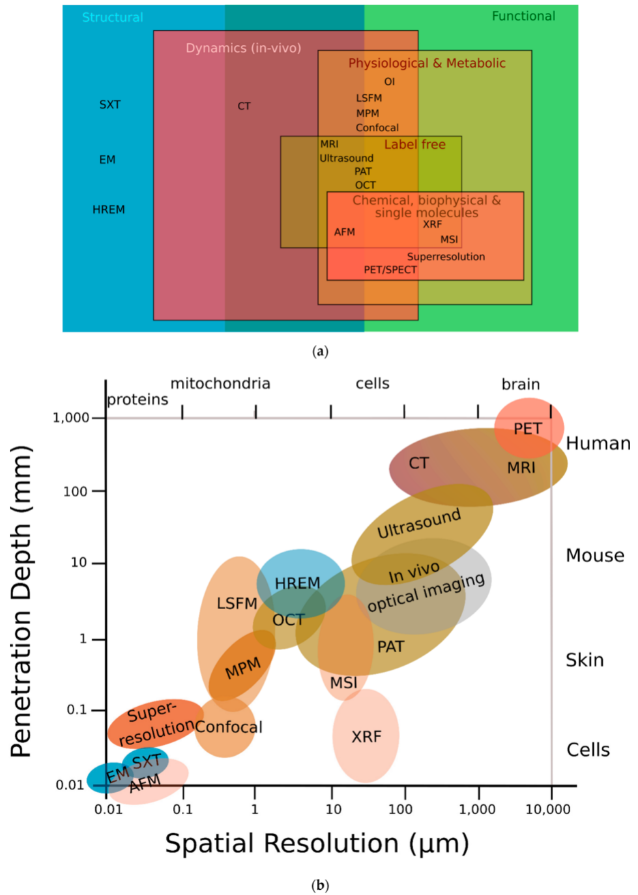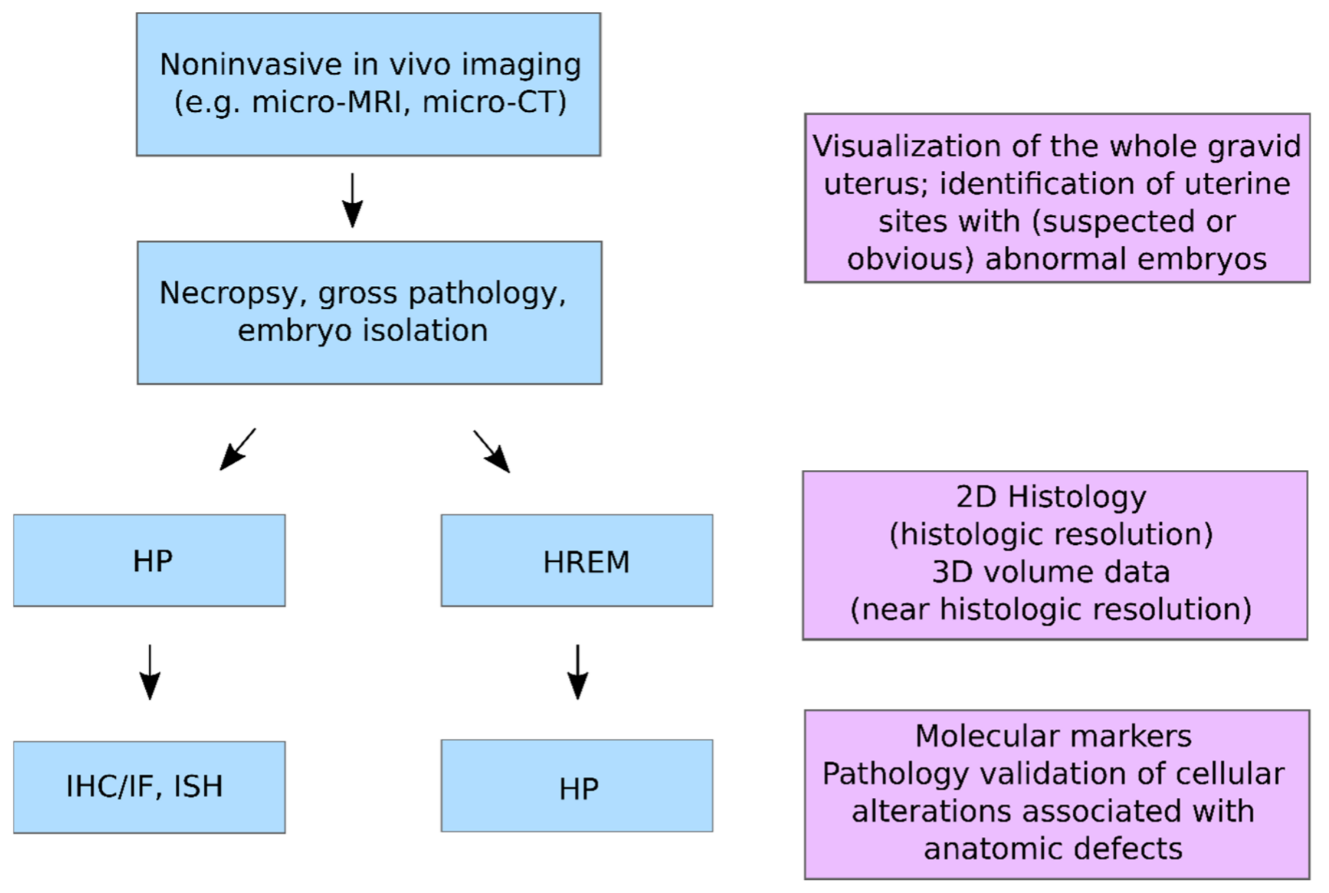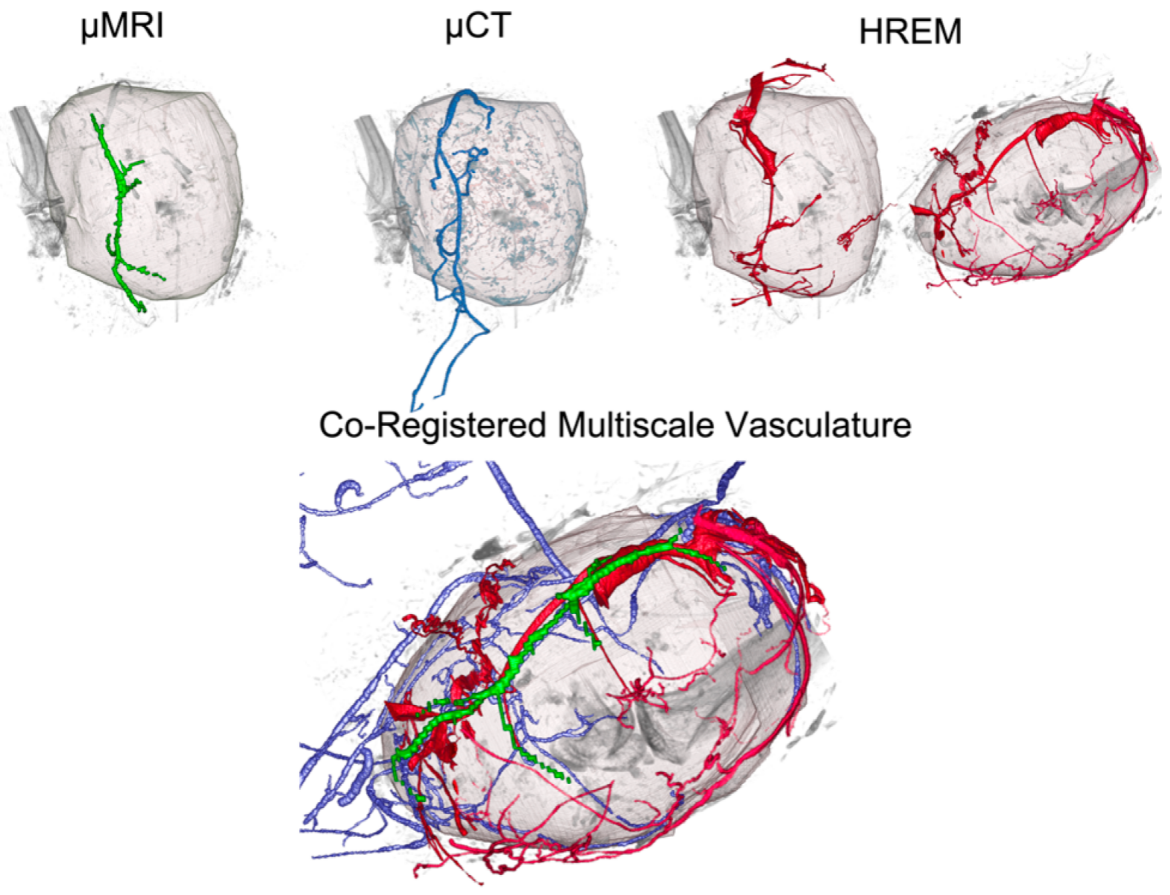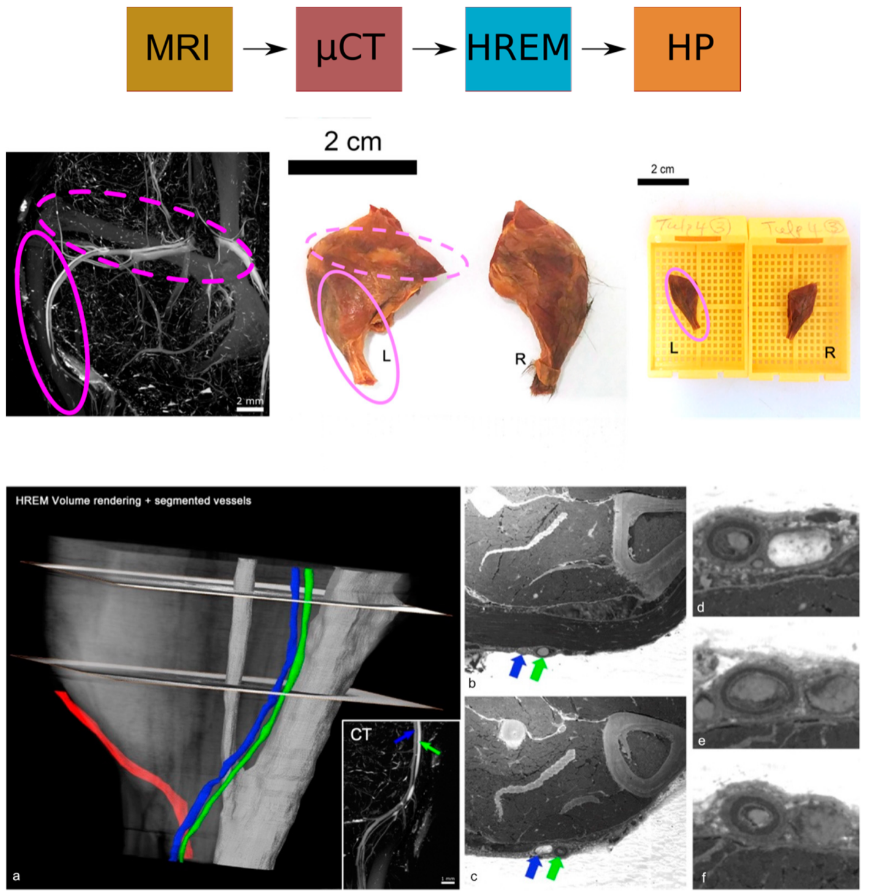High-resolution episcopic microscopy (HREM) is a three-dimensional (3D) episcopic imaging modality based on the acquisition of two-dimensional (2D) images from the cut surface of a block of tissue embedded in resin. Such images, acquired serially through the entire length/depth of the tissue block, are aligned and stacked for 3D reconstruction. HREM has proven to be specifically advantageous when integrated in correlative multimodal imaging (CMI) pipelines. CMI creates a composite and zoomable view of exactly the same specimen and region of interest by (sequentially) correlating two or more modalities. CMI combines complementary modalities to gain holistic structural, functional, and chemical information of the entire sample and place molecular details into their overall spatiotemporal multiscale context. HREM has an advantage over in vivo 3D imaging techniques on account of better histomorphologic resolution while simultaneously providing volume data. HREM also has certain advantages over ex vivo light microscopy modalities. The latter can provide better cellular resolution but usually covers a limited area or volume of tissue, with limited 3D structural context.
- high-resolution episcopic microscopy
- correlated multimodal imaging (CMI)
- correlation
- microscopy
- preclinical imaging
- COMULIS
- discovery pathology
- histopathology
- correlative morphology
- phenotyping
- bioimaging
- mouse embryo
- block face imaging
- mesoscopy
1. Introduction
-
Combinations of light microscopy and electron microscopy (EM) have been in vogue for diagnostic and research applications. In clinical and some preclinical settings, such combinations are well established in the forms of histopathology (HP) and ultrastructural pathology. In recent times, the combined application of HP, immunohistochemistry, and electron microscopy (scanning and transmission) is central to the characterisation of pulmonary lesions in fatal cases of COVID-19 [12]. In biological research, the combination of these two microscopic modalities is designated as correlative light and electron microscopy (CLEM) [13,14][13][14].
Advantages and Limitations of HREM in a Multimodal Context

| Modality | Contrast | Penetration (mm) | Lateral Resolution (µm) | VOI | Advantages | Limitations | |||||
|---|---|---|---|---|---|---|---|---|---|---|---|
| micro-MRI | Emitted RF signal after nuclear spin excitation | >500 | ≤100 | whole organism |
|
| |||||
| micro-US | Acoustic impedance between tissue interfaces; detection of echoes from moving particles |
<150 | 30–800 | whole organism |
|
| |||||
| PAT | Acoustic waves generated by optical absorption of tissue chromophores | ~10 | ~40 | 10 × 10 mm | 2 |
|
| ||||
| OCT | Optical scattering based on refractive index changes; motion contrast due to blood flow (OCT angiography) |
~1–2 | 1–10 (diffraction limited) | 10 × 10 mm | 2 |
|
| ||||
| micro-PET | Photon emission after positron annihilation | >500 | 1000–2000 | whole organism |
|
| |||||
| micro-CT | Differential X-ray attenuation of tissues related to their density | >500 | ≤100 | whole organism |
|
| |||||
| HREM | Light scattering based on unspecific eosin staining | Sample size up to 12 mm in thickness | >1 | 8 mm × 8 mm × 12 mm |
|
| |||||
| HP | Light scattering (various staining methods impart colour and contrast to cellular and tissue components) |
<0.1 | >500 | up to 1 mm | 3 |
|
|
2. State-of-the-Art
HREM is compatible with a wide range of fixatives and various contrast agents, and tissue processing for HREM does not require special chemicals except for resin embedding and contrasting with eosin. Therefore, HREM can be easily combined with almost all upstream and downstream techniques in multimodal imaging pipelines. It proved to be the method of choice to correlatively reconstruct tumour capillaries and murine vasculature of sufficient contrast and quality at micrometre resolution in selected volumes of interest (VOIs), and to visualise minute anatomical structures and volume displays of mouse, chick, and zebrafish embryos (such as heart malformations) in combination with optical coherence tomography (OCT), photoacoustic tomography (PAT), micro-US, micro-CT, and micro-MRI. HREM was shown to be compatible with contrast agent-enhanced CT and micro-MRI and with the fixation, staining, and dehydration media used after tumour and embryo removal for ex vivo micro-CT or HP. Even though HREM is destructive to the tissue, it can be combined and correlated with HP by collecting physical sections for subsequent examination.2.1. HP and HREM: Mutual Complementarity
| HP | 1 | HREM | 2 | |
|---|---|---|---|---|
| Fixation | Predominantly aldehyde-based fixatives (10% formaldehyde, 4% paraformaldehyde, Bouin’s fluid) |
Predominantly aldehyde-based fixatives (10% formaldehyde, 4% paraformaldehyde, Bouin’s fluid) |
||
| Processing (infiltration) |
Automated or manual processing Paraffin (most common) Resin, agar, gelatine, celloidin (alternative, less common) |
Manual processing Resin (JB-4) |
||
| Embedding | Paraffin Resin |
Resin (JB-4) | ||
| Sectioning | Manual rotary microtomy Automated microtomy |
Automated microtomy | ||
| Sectioning | Single or multiple sections at specific planes of the embedded tissue for most routine diagnostic cases and discovery projects; serial sections are reserved for specialised analyses | Serial sections (at specific intervals through the entire thickness of the block) | ||
| Section thickness | 1 µm to 5 µm | 1 µm to 3 µm | ||
| Staining | Tissue sections are placed on glass slides and then stained | Tissues are stained during infiltration (prior to embedding) | ||
| Stains | Several histochemical stains including Hematoxylin and Eosin (H&E), Periodic Acid Schiff (PAS) and Luxol Fast Blue (LFB) | Eosin | ||
| Imaging | Light microscopy, multiple objectives and magnifications | Light microscopy, single objective and magnification (selected at the start of sectioning) | ||
| Imaging surface | Tissue section on glass slide | Cut surface of resin block | ||
| Visualisation and resolution | 2D; higher histomorphologic and cellular resolution with better discernment of specific lesions | 3 | 2D and (virtual/reconstructed) 3D; broader spatial resolution and architectural overview with lower cellular resolution (than HP) | 3 |
| Spatial contextual analysis of molecular (protein and nucleic acid) markers | More options for immunostaining and in situ hybridisation on paraffin embedded sections | Fewer options for immunostaining and in situ hybridisation on JB-4 resin embedded sections |
2.2. Multimodality HREM to Image Mouse, Chick, Quail, Frog, and Zebrafish Embryos

2.2.1. Visualising Gene Activity within Tissue
2.2.2. Combining Micro-MRI and HREM for the Analysis of Murine Embryos
2.2.3. From In Vivo to High Resolution Using OCT, PAT, and HREM
2.2.4. CMI Pipeline to Track the Genesis of Congenital Heart Malformations
2.3. Multimodality HREM to Assess Murine Vasculature
2.3.1. Murine Tumour Vasculature

2.3.2. Murine Vascular Lesions

References
- Walter, A.; Mannheim, J.G.; Caruana, C.J. Imaging Modalities for Biological and Preclinical Research: A Compendium, Volume 1: Part I: Ex Vivo Biological Imaging; IOP Publishing: Bristol, UK, 2021; ISBN 978-0-7503-3059-6.
- Day, C.E. Histopathology: Methods and Protocols; Day, C.E., Ed.; Methods in Molecular Biology; Springer: New York, NY, USA, 2014; Volume 1180, ISBN 978-1-4939-1049-6.
- Geyer, S.; Maurer-Gesek, B.; Reissig, L.F.; Weninger, W.J. High-resolution Episcopic Microscopy (HREM)-Simple and Robust Protocols for Processing and Visualizing Organic Materials. J. Vis. Exp. 2017, e56071.
- Weninger, W.J.; Geyer, S.H. Episcopic 3D Imaging Methods: Tools for Researching Gene Function. Curr. Genom. 2008, 9, 282–289.
- Weninger, W.J.; Geyer, S.; Martineau, A.; Galli, A.; Adams, D.J.; Wilson, R.; Mohun, T.J. Phenotyping structural abnormalities in mouse embryos using high-resolution episcopic microscopy. Dis. Model. Mech. 2014, 7, 1143–1152.
- Geyer, S.H.; Reissig, L.F.; Hüsemann, M.; Höfle, C.; Wilson, R.; Prin, F.; Szumska, D.; Galli, A.; Adams, D.J.; White, J.; et al. Morphology, topology and dimensions of the heart and arteries of genetically normal and mutant mouse embryos at stages S21–S23. J. Anat. 2017, 231, 600–614.
- Walter, A.; Paul-Gilloteaux, P.; Plochberger, B.; Sefc, L.; Verkade, P.; Mannheim, J.G.; Slezak, P.; Unterhuber, A.; Marchetti-Deschmann, M.; Ogris, M.; et al. Correlated Multimodal Imaging in Life Sciences: Expanding the Biomedical Horizon. Front. Phys. 2020, 8, 47.
- Bosch, C.; Karreman, M.A.; Pacureanu, A.; Schaefer, A.T.; Walter, A. Correlative Multimodality Imaging across Scales. In Imaging Modalities for Biological and Preclinical Research: A Compendium; IOP Publishing: Bristol, UK, 2021; Volume 2, pp. III.3-1– III.3-12.
- Reier, S.; Turyanskaya, A.; Heimel, P.; Frischauf, N.; Meusburger, D.; Heuser, T.; Drexler, N.; Janovszky,, Á.; Streli, C.; Slezak, P.; et al. Cross-modality imaging of bisphosphonate-treated murine jawbones. Analyst 2021, 146, 4683–4699.
- Gourtsoyiannis, N.C.; Ros, P.R. Radiologic-Pathologic Correlations from Head to Toe Understanding the Manifestations of Disease; Springer: Berlin/Heidelberg, Germany, 2005; ISBN 978-3-540-26664-8.
- Gabrielson, K.; Maronpot, R.; Monette, S.; Mlynarczyk, C.; Ramot, Y.; Nyska, A.; Sysa-Shah, P. In Vivo Imaging With Confirmation by Histopathology for Increased Rigor and Reproducibility in Translational Research: A Review of Examples, Options, and Resources. ILAR J. 2018, 59, 80–98.
- Ackermann, M.; Verleden, S.E.; Kuehnel, M.; Haverich, A.; Welte, T.; Laenger, F.; Vanstapel, A.; Werlein, C.; Stark, H.; Tzankov, A.; et al. Pulmonary Vascular Endothelialitis, Thrombosis, and Angiogenesis in COVID-19. N. Engl. J. Med. 2020, 383, 120–128.
- Watari, N.; Tsukagoshi, N.; Honma, Y. The Correlative Light and Electron Microscopy of the Islets of Langerhans in Some Lower Vertebrates. Arch. Histol. Jpn. 1970, 31, 371–392.
- Jahn, K.; Barton, D.; Kobayashi, K.; Ratinac, K.; Overall, R.; Braet, F. Correlative microscopy: Providing new understanding in the biomedical and plant sciences. Micron 2012, 43, 565–582.
- Zopf, L.M.; Heimel, P.; Geyer, S.H.; Kavirayani, A.; Reier, S.; Fröhlich, V.; Stiglbauer-Tscholakoff, A.; Chen, Z.; Nics, L.; Zinnanti, J.; et al. Cross-Modality Imaging of Murine Tumor Vasculature—A Feasibility Study. Mol. Imaging Biol. 2021, 23, 874–893.
- Keuenhof, K.; Heimel, P.; Zopf, L.; Raigel, M.; Turyanskaya, A.; Kavirayani, A.; Reier, S.; Glösmann, M.; Schöfer, C.; Kralovics, R.; et al. Multimodality imaging beyond CLEM: Showcases of combined in-vivo preclinical imaging and ex-vivo microscopy to detect murine mural vascular lesions. Methods Cell Biol. 2020, 162, 389–415.
- Walter, A.; Mannheim, J.G.; Caruana, C.J. Preclinical and Multimodality Imaging. In Imaging Modalities for Biological and Preclinical Research: A Compendium, Volume 2; IOP Publishing: Bristol, UK, 2021; pp. 2053–2563. ISBN 978-0-7503-3747-2.
- Walter, A.; Munoz-Baruttia, A.; Jones, M.; Mannheim, J.G.; Collinson, L.; Andreana, M.; Unterhuber, A.; Verkade, P. Emerging Technologies and Outlook. In Imaging Modalities for Biological and Preclinical Research: A Compendium, Volume 2; IOP Publishing: Bristol, UK, 2021; pp. IV.1-1–IV.1-14.
- Potts, S.J.; Eberhard, D.A.; Wharton, K.A. Methods in Pharmacology and Toxicology. In Molecular Histopathology and Tissue Biomarkers in Drug and Diagnostic Development; Humana Press: New York, NY, USA, 2015; ISBN 978-1-4939-2680-0.
- Haschek, W.M.; Rousseaux, C.G.; Wallig, M.A. Haschek and Rousseaux’s Handbook of Toxicologic Pathology; Academic Press: Amsterdam, The Netherlands, 2013; ISBN 978-0-12-415765-1.
- Cardiff, R.D.; Ward, J.M.; Barthold, S.W. ‘One medicine—One pathology’: Are veterinary and human pathology prepared? Lab. Investig. 2007, 88, 18–26.
- Schofield, P.N.; Vogel, P.; Gkoutos, G.V.; Sundberg, J.P. Exploring the elephant: Histopathology in high-throughput phenotyping of mutant mice. Dis. Model. Mech. 2012, 5, 19–25.
- Kumar, V.; Abbas, A.K.; Aster, J.C.; Cotran, R.S.; Robbins, S.L. Robbins and Cotran Pathologic Basis of Disease; Elsevier: Amsterdam, The Netherlands, 2015; ISBN 978-0-323-29639-7.
- Ward, J.M.; Elmore, S.A.; Foley, J.F. Pathology Methods for the Evaluation of Embryonic and Perinatal Developmental Defects and Lethality in Genetically Engineered Mice. Veter-Pathol. 2011, 49, 71–84.
- Bolon, B. Pathology of the Developing Mouse: A Systematic Approach; CRC Press: Boca Raton, FL, USA, 2015; ISBN 978-0-429-13945-1.
- Pieles, G.; Geyer, S.H.; Szumska, D.; Schneider, J.; Neubauer, S.; Clarke, K.; Dorfmeister, K.; Franklyn, A.; Brown, S.D.; Bhattacharya, S.; et al. µMRI–HREM pipeline for high-throughput, high-resolution phenotyping of murine embryos. J. Anat. 2007, 211, 132–137.
- Weninger, W.J.; Geyer, S.; Mohun, T.J.; Rasskin-Gutman, D.; Matsui, T.; Ribeiro, I.M.; Costa, L.D.F.; Izpisúa-Belmonte, J.C.; Müller, G.B. High-resolution episcopic microscopy: A rapid technique for high detailed 3D analysis of gene activity in the context of tissue architecture and morphology. Brain Struct. Funct. 2006, 211, 213–221.
- Walsh, C.; Holroyd, N.A.; Finnerty, E.; Ryan, S.G.; Sweeney, P.W.; Shipley, R.J.; Walker-Samuel, S. Multifluorescence High-Resolution Episcopic Microscopy (MF-HREM) for Three-Dimensional Imaging of Adult Murine Organs. Adv. Photonics Res. 2021, 10, 2100110.
- Jenkins, M.W.; Chughtai, O.Q.; Basavanhally, A.N.; Watanabe, M.; Rollins, A.M. In vivo gated 4D imaging of the embryonic heart using optical coherence tomography. J. Biomed. Opt. 2007, 12, 030505.
- Laufer, J.; Norris, F.; Cleary, J.; Zhang, E.; Treeby, B.; Cox, B.; Johnson, P.; Scambler, P.; Lythgoe, M.; Beard, P. In vivo photoacoustic imaging of mouse embryos. J. Biomed. Opt. 2012, 17, 0612201–0612208.
- Liu, M.; Maurer, B.; Hermann, B.; Zabihian, B.; Sandrian, M.G.; Unterhuber, A.; Baumann, B.; Zhang, E.Z.; Beard, P.C.; Weninger, W.J.; et al. Dual modality optical coherence and whole-body photoacoustic tomography imaging of chick embryos in multiple development stages. Biomed. Opt. Express 2014, 5, 3150–3159.
- Desgrange, A.; Lokmer, J.; Marchiol, C.; Houyel, L.; Meilhac, S.M. Standardised imaging pipeline for phenotyping mouse laterality defects and associated heart malformations, at multiple scales and multiple stages. Dis. Model. Mech. 2019, 12, dmm038356.
- Buja, L.M.; Butany, J. Cardiovascular Pathology; Academic Press: London, UK; Elsevier: London, UK, 2016; ISBN 978-0-12-800459-3.
- Ribatti, D.; Pezzella, F. Tumor Vascularization, 1st ed.; Academic Press: London, UK; Elsevier: London, UK, 2020; ISBN 978-0-12-819494-2.
